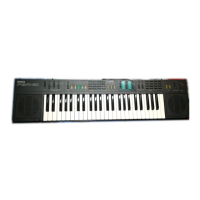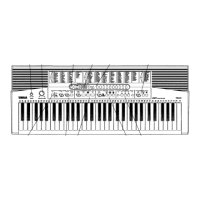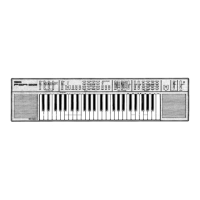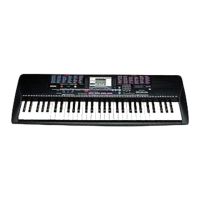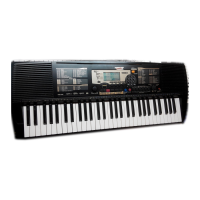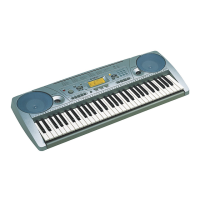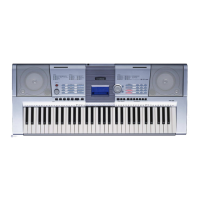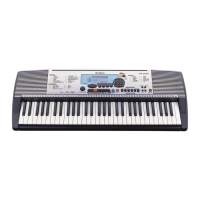
Do you have a question about the Yamaha PortaTone PSR-210 and is the answer not in the manual?
| Voices | 100 |
|---|---|
| Styles | 100 |
| Display | LCD |
| MIDI | No |
| Speakers | 2 x 2.5W |
| Type | Portable Keyboard |
| Number of Keys | 61 |
| Effects | Reverb, Chorus |
| Connectors | Headphone |
Important notices regarding safe operation, maintenance, environmental considerations, and battery/disposal guidelines.
Details on specifications subject to change and location of the product's name plate.
Guidelines on modification, cable usage, and interference compliance for FCC regulations.
Detailed description of the PSR-210 control panel buttons and their functions.
Identification and function of rear panel jacks for power, sustain, and audio output.
Detailed description of the PSR-310 control panel buttons and their functions.
Identification and function of rear panel jacks for power, audio, MIDI, and sustain.
Safety precautions for product location, handling, and general care.
Step-by-step guide for connecting the AC power adaptor to the keyboard.
Instructions for installing batteries into the keyboard for power.
How to connect headphones or an amplifier to the keyboard for audio output.
Instructions for connecting a sustain pedal and inserting the music stand.
How to turn the keyboard on/off and adjust the master volume level.
Steps to select and play built-in demonstration songs on the keyboard.
Guide to selecting and playing one of the 100 available instrument voices.
Information on using keyboard keys for drum and percussion instrument sounds.
How to choose from five different Auto Harmony types for musical accompaniment.
Instructions on activating the sustain effect and using it with Split mode.
How to enable and use Touch Response to control sound loudness with playing dynamics.
How to activate and use the Dual Voice feature to layer two sounds simultaneously.
Steps to activate Split mode, dividing the keyboard into two sections.
How to adjust the key that separates the left and right-hand sections in Split mode.
How to select different voices for the left and right-hand sections in Split mode.
How to shift the keyboard's pitch up or down to play in different keys.
Guide to choosing from the available accompaniment styles for musical backing.
Explanation of Single Finger and Fingered modes for playing chords.
How to play various chord types using the Fingered mode for accompaniment.
Methods for initiating accompaniment playback using various buttons and modes.
Using INTRO/FILL IN and START/STOP buttons for accompaniment control.
How to adjust the tempo and understand the beat display.
How to adjust the volume of the accompaniment section.
How to insert fill-in patterns to add variation during accompaniment.
Methods for stopping the accompaniment playback with or without an ending.
How to select and play the 15 built-in demonstration songs.
How to play along with songs by removing the melody line.
Step-by-step guide for recording chord and melody sequences.
How to play back previously recorded musical sequences.
Instructions for programming and playing back sequences in a chain.
Guide to choosing and triggering the 40 available sound effects.
How to use the keyboard to control or be controlled by other MIDI devices.
Using the keyboard as a tone generator receiving data from other MIDI devices.
How to configure the keyboard to send MIDI messages on specific channels.
How to configure the keyboard to receive MIDI messages on specific channels or OMNI ON.
Procedures for resetting Chord Memory, Chain Memory, and Split Points.
Information on the maximum number of notes that can sound simultaneously.
Details on data transmitted and recognized in Remote Control mode.
Details on data transmitted and recognized in Multi mode.
